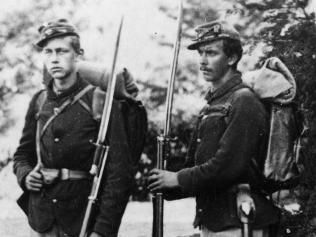Although there is evidence that women (who disguised their female appearance to serve in the rank unnoticed- at least until disease or a battlefield wound bared enough female pulchritude to leave nothing to the imagination), there is no documented evidence that a woman ever served in the ranks of the Third New Jersey Volunteers. So, being somewhat politically incorrect, who was the typical Federal soldier?
They were young men for the most part- 18, 19, 20, and 21 years old. At the outbreak of hostilities, 18 year olds needed their parents consent to serve. However, after 1862, the Army could not accept any under 18 years. 10,000+ teenagers served in the Union. But their fathers served as well: there were 14,000+ men over 45 in the ranks. In general, however, 3/4 of the Union army was under 30 years of age. Fully 50% of the Union was under 25!
They were mostly well educated. The average company of a Union regiment only had 1-6 illiterates. Many companies had none!
Although 3/4 of Union soldiers were Americans, 1/4 were of foreign birth, mostly Germans, Irish, Canadians, and British. Why did so many foreigners serve? Many had a deep love of Union -and their new country. Many came from European countries where freedom was a dream, not a reality. Many thought that military service would lead to greater acceptance in their adopted country. Still others joined because they had families to feed and provide for. Ultimately, the latter reason may be the prevailing motive for military service for the percentage of foreigners in uniform as war progressed – enticed by “employment” and the huge bounties then being offered by county and state agencies to help meet draft quotas.
On April 15, 1861, President Lincoln called for 75,000 volunteers. New Jersey militia troops quickly filled these 90 day enlistments. Shortly thereafter, on May 3, 1861 the President authorized raising 500,000 volunteers for 3-year enlistments. New Jersey raised 3 regiments and by June 1861, the First New Jersey Brigade was formed. The companies, organized at county courthouses, reported to Trenton, where the men were mustered into service at Camp Olden. Over the course of the bitter war, New Jersey raised 40 regiments: 33 infantry, 5 cavalry, and 2 artillery. Once mustered into Federal service, the volunteers found himself part of the military organization known as a Regiment, containing 39 officers and 986 men made up of 10 companies. Each Company consisted of 3 officers and 98 men. Each company was further divided into 2 platoons. Each platoon was divided into 2 sections.
The Regiment was a part of a larger organization, called a Brigade, which consisted of 3 or 4 Regiments. A Division usually consisted of 3 or 4 Brigades. A Corps consisted of 2 or more Divisions. Finally, an Army consisted of 1 or more Corps. Military service fosters strong attachments to the men a soldier serves with on a daily basis. The esprit de Regiment held the strongest ties for the men but the esprit de Corps also produced strong ties. Military successes helped forge strong Corps identities. Sometimes, outward symbols helped produce a feeling of belonging to a larger organization. For example, in March 1863, Major General Hooker authorized the designation of Corps badges. The color of the badge designated the Division within each Corps: red = 1st Division; white = 2nd Division; and blue = 3rd Division.
Harmony and sometimes discord were produced as a result of state pride, the prejudice of regulars against volunteers, and of volunteers against conscripts of bounty men. Incidentally, since many of the men of a Company typically came from the same geographic area, they shared a common knowledge. Furthermore, since a Regiment was comprised of Companies raised in a single state, the men would probably know quite a bit about the more notable political leaders, as well as their “key” officers. As part of a military organization, the men would also learn to recognize military rank.

